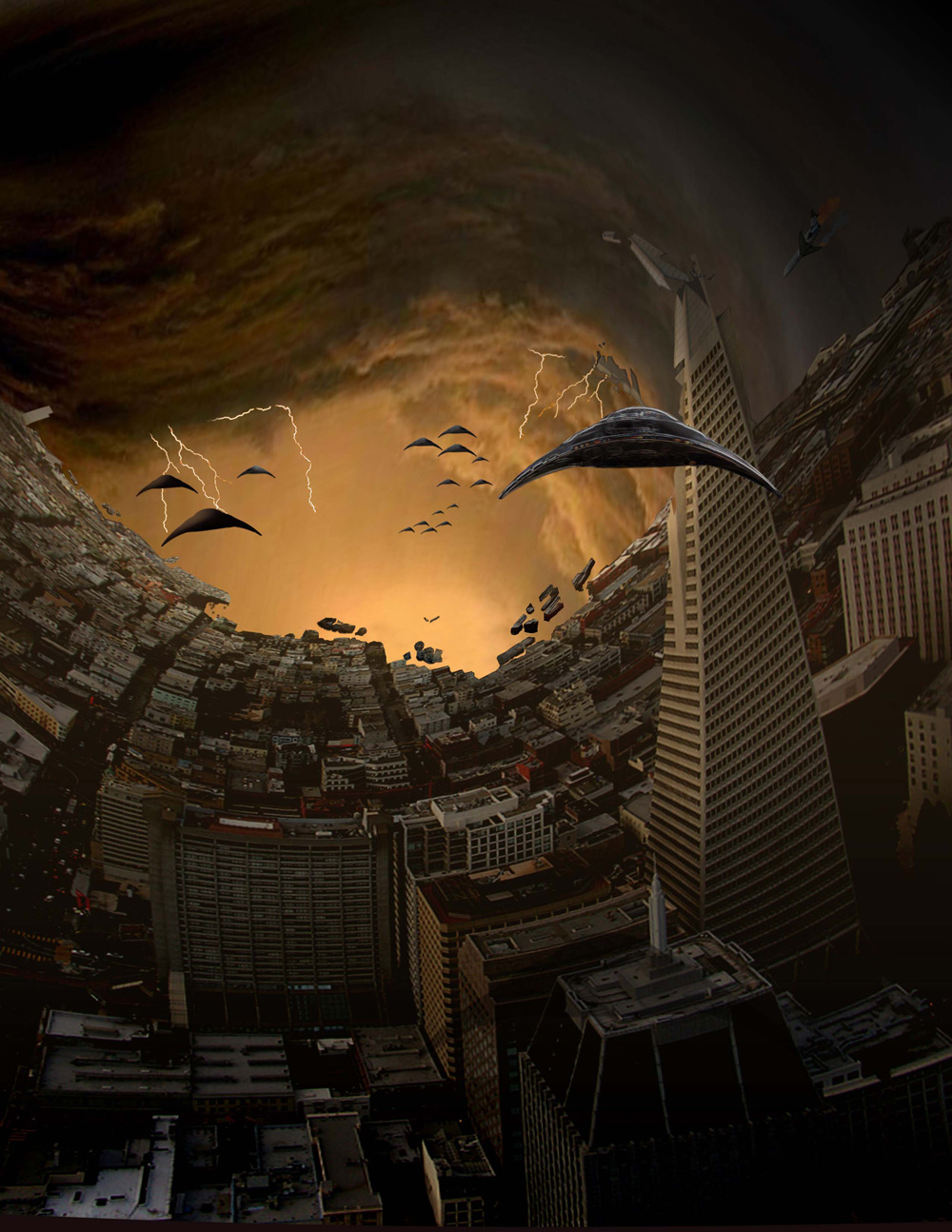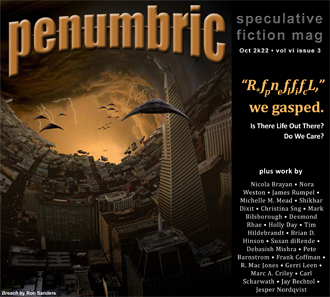
Breach by Ron Sanders
September was such a busy news month, with the Queen of England dying and wars and new leaders screwing up economies and just, well, stuff, that I almost missed it: Frank Drake had died.
For those who do not know who he was, Dr. Drake came up with one of the most famous (and vague, in a way) equations in astronomy and astrophysics: the Drake equation, which is used to estimate the number of extraterresrial civilizations in our galaxy currently capable of communicating with us in some fashion. In other words, it’s kind of the equation for Who Is Out There?
It wasn’t meant as a quantifiable, or truly solvable, equation. When Drake formulated it in 1961, it was meant to stimulate discussion at the [first] meeting regarding SETI (the Search for Extraterrestrial Intelligence). Many of the numbers in the equation are guesswork even today, but it is certain that, in order to begin to even guess Who Is Out There, we have to think carefully about each of these factors, such as how many stars form in our galaxy, which of those have planets that can support life, and which of those lifeforms go on to develop technology that advertises their existence across the vastness of space.
However, although the equation itself has been debated and amended, there are other, non-scientific factors that play into it—or at least, the effect it has on our world as humans. Back in the 1960s, we were fascinated by space and all it could hold; even through the 1990s, we wondered weekly about the Truth out there in
The X-Files and other shows/films. But somehow, as the new millenium dawned and it dawned on us that we might destroy our own lives on Earth before we ever reached cities on the Moon and Mars, we became much more worried about social inequalities, climate change, and (for a second time) nuclear destruction than about Little Green Men. Ironically, as our movies have become chock full of superheroes and ETs, our day-to-day imaginations seem filled with more down-to-earth problems.
So does SETI matter anymore? Do we care? Should we be worried that we’ll be invaded by hostile aliens (as this month’s cover suggests), or should we be hoping for some kind of extraterrestrial intervention to save us from ourselves?
What is the Drake Equation, anyway?
The equation itself is:
N = R*fpneflfifcL
Where
N is the number of Milky Way civilizations with which we can communicate (or accidentally/on purpose have communicated through our own radio/TV emissions into space or through spaceships like
Voyager 1 and
2). The factors going into this calculation are thus:
R* is the average rate stars form in the Milky Way
fp is the fraction of those with planets
ne is the average number of those planets (per star) that can support life
fl is the fraction of those planets that actually develop life
fi is the fraction of those that develop civilizations
fc is the fraction of those that develop tech that sends detectable signs of their exsitence into space
L is the length of time those civs actually release those signs before being destroyed or destroying themselves
As you can see, each factor reduces the overall number, potentially reducing the number to as low as 1 (since we, at least for now, are the one civ we know of that filters through the entire equation). At the time Drake created it, the equation had many factors that were unknown or unknowable. You can find the exact estimates elsewhere (Wikipedia for example), but overall the range of N was thought to be between 20 and 50,000,000 currently communicating alien civilizations (and I guess one of those would be us, so the minimum might be 19). Now, of course, we have much more precise estimates of some of the factors, and we’ve discovered planets around nearly every star system (where the original estimate was more like one-fifth to one-half), so you’d think the end result could be much higher. You’d think.

Where are they?
As numerous as we think they could be, why haven't any aliens contacted us yet?
If there is intelligent life out there, why have they not contacted us? This has been a hot topic in SETI research since well before Drake and his equation; physicist Enrico Fermi is attributed with blurting out something like “But where is everybody?” in response to a discussion on the lack of contact vs the supposed abundance of life in the universe. This became known as “Fermi’s Paradox.”
There are a number of possibilities. One of these is that we’ve vastly overestimated the number of civilizations or even planets with life in the universe; maybe no one is out there. Another is that, even with a number of civilizations arising within, say, our galaxy, the odds of their development overlapping with ours time-wise and also doing something we’d have detected in the brief time we’ve been capable of looking are very, very low. In this case it could either just be a matter of time before we find them (or they find us), or we may only find their remains (or, again, they could find ours).
There’s the related possibility that we just don’t understand the communication that’s been aimed at us. Or the Star Trek IV idea that they’re trying to contact intelligent life on this planet, but that intelligent life just ain’t us. Or the possibility that they know about us, but because they have their own “prime directive” about contacting primitive (to them) lifeforms, they’re sitting out there waiting for us to do something smart.
Of course, while some people hope for alien contact, others see it as dangerous. What if the aliens who find us are just as warlike, racist, and arrogant as some of us? What if they see us as a prime candidate for being conquered, or taken as slaves, or just plain destroyed to make room for their own people? In that case, we’d be better off being alone in the universe. Or at least as well off as we are now.
Mislaid Hopes and Modern Reinterpretations
There are those who would say our hopes for extraterrestrial life are mislaid, for while the number of exoplanets is far greater than we could have wished, many of those are giant gas planets that may disrupt the orbits of any Earth-like planets; and there may be a number of other constraints beyond being in a sort of Golidlocks habitable zone around a star—Goldilocks’ rules for habitable planets may extend to extra-system factors like having the right combinations of heavy metals or other elements, not being in a galactic radiation hot zone, or even having the right kind of moon.
I think these rules are a bit too pessimistic, not least because our ideas about what life is and how it forms are exceedingly limited (limited to only one example, in fact). It is as arrogant to assume all life must be based on things we can understand as it was to assume the Earth was the center of the universe.
Recently (or recently-ish, in the last ten years or so), Sara Seager of MIT revised Drake’s equation in several small ways and one big one—adding a factor for planets on which life produces a “detectable signature gas.” As we’ve become better at detecting exoplanets, we’ve become able to not only detect earth-like planets (using satellites that escape the problems of looking through earth’s atmosphere) but also potentially use the relatively new James Webb Space Telescope “to observe the atmospheres of those planets” (Seager, NASA interview, 2 September 2013). If we can detect gases in those atmospheres that indicate life (biosignature gases), well, that’d be a game changer. However, we’re still unsure just which gases would be good biosignature candidates. Common gases like carbon dioxide are common even without life. Ammonia may work (albeit indicating a planet with life different to Earth’s, according to Sukrit Ranjan and others (Sky at Night)), and some researchers are hoping to look for this in the near future. However, Seager’s new equation doesn’t necessarily estimate intelligent life, so it might be seen as getting away from SETI’s mission.
We have, by the way, discovered rocky exoplanets since that Seager interview, starting with Kepler-186f, the first earth-like planet found in what we think of as the habitable zone of a star. It’s twice the size of Earth and has years half as long, but it fills the bill, as it were. What we haven’t been able to discover yet is whether it actually is inhabited.

We’re trying to demonstrate that L is a low number indeed
Face it, our own real-time demonstration of whether N can ever be much greater than 1 at any given time is not going well. It feels like at any moment, geologically speaking, we may extinguish ourselves through global war, own-goal pandemics, or poisoning our planet to such an extent that we can’t even breathe, eat, or survive anymore. We survived one cold nuclear war only to be facing the potential for another, warmer one. We argue whether human-induced climate change is real even while the Earth burns and sea levels rise in front of us, all so a few of the short-term-minded people around us can continue to make money in old-fashioned ways like sucking long-dead-animal products out of the ground. And we seem to be in a rush to put blinders on and pretend that only those of “us” in our own made-up nation-states are the best humans, that somehow the rest of the world is made up of undesirable peoples or enemies that we must compete against. Is it any wonder that any aliens would give this planet a wide berth?
Regardless, no matter the number of galactic civilizations out there sending out radio signals and interstellar spacecraft, for one reason or other they have not contacted us (see sidebar), or we have not figured out that they’re trying to contact us, and thus our attention, as it is wont to do, has wandered away from the search for extraterrestrial life and even space exploration, and (with some good reason) is now firmly fixed on terra firma--Mars rovers and sending billionaires into space notwithstanding.
“ET was a movie, right?”
So do we think about ETs anymore? Compared to the promises made in the 1960s and 70s (of cities on the Moon and starships galavanting proudly among the stars), we barely explore space; we’re lucky that a small percentage of the population cares enough to get things like the Mars Rovers and the James Webb telescope off the ground (and probably lucky that a large percentage don’t pay attention to the money spent on such things, since we also don’t do a good job of trumpeting all the good things that have come of space exploration—like that mobile computer in everyone’s hands). Congress plays around with appropriating money for SETI-like projects, but ultimately is only using the idea to score political points with its corporate heroes (on the Repub side) or the “common man” (on the Dems’ side, where many of them basically argue that using money for such “foolishness” throws taxpayer’s money out the airlock). The idea of aliens is right there with superheroes and other escapism—both saturating our lives yet, day-to-day, not an immediate issue, like shelter, food, jobs, people’s rights, etc.
If asked, the person on the street can certainly conjure up enthusiasm about such scifi ideas as aliens—hence one reason for the popularity of science fiction films. If not asked, they don’t really worry about it. Why? Because no matter whether the potential aliens would be good or evil, no matter their intention to ask us to join the intersteallar federation of like-minded planets or subjugate us to their galactic empire, for all intents and purposes their potentiality does not affect anyone in their day-to-day lives. Online threads on this subject tend to move toward this conclusion: whether skeptical of alien life or hopeful that it exists, for most people it is not even near the list of “things to do today.” Heck, we can’t even keep climate change top-of-mind without it being reinforced by local weather events or cable news channels (half of which encourage us to deny it is even happening).
Worse, we let the people in power take advantage of this inability to look at a picture bigger than our own backyard to get their own short-term agendas passed into laws we then obey without too much grumbling, especially if we can get our circuses through divisive cable news and social media. Not that these things need to be divisive, but as we use them, they are. In other words, we do not need to think of aliens from outer space; we make our aliens right here, looking at other humans as though they are not human at all.
And given our myopia, given that our only way to make ourselves “great” seems to be through the exploitation and subjugation of our other selves, it is no surprise to me that the only time we look to the stars is to indulge fantasies, either of greatness or horror. And it is lucky we do, for such stories may be what, in the end, teach us how to get along with ourselves. And this is not only a prerequisite for surviving our own destructive tendencies. We cannot be friends with or friendly to beings not of this world until we can be friends with our own neighbors, our own selves.














